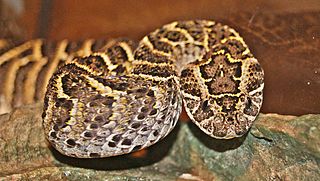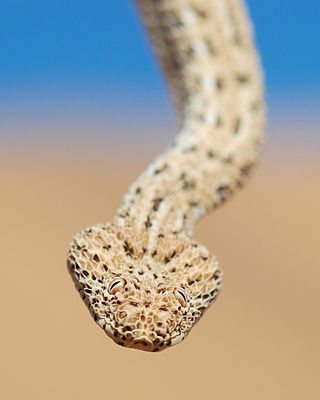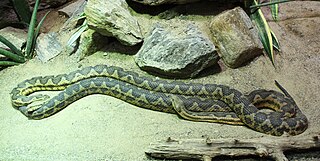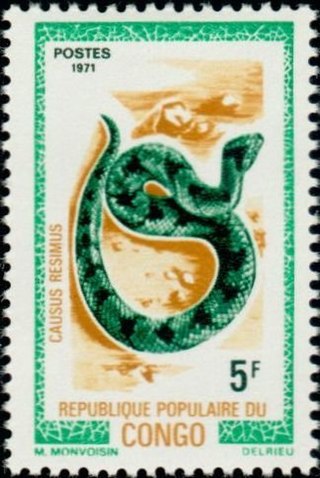
The Gaboon viper, also called the Gaboon adder, is a large and highly venomous viper species found in the rainforests and savannas of sub-Saharan Africa. Like all other vipers, it is venomous. It is the largest member of the genus Bitis, and has the longest fangs of any venomous snake – up to 2 inches (5.1 cm) in length – and the highest venom yield of any snake. No subspecies are recognized.

The puff adder is a highly venomous viper species found in savannahs and grasslands from Morocco and western Arabia throughout Africa except for the Sahara and rainforest regions. It is responsible for causing the most snakebite fatalities in Africa owing to various factors, such as its wide distribution, frequent occurrence in highly populated regions, and aggressive disposition. Like all other vipers, it is venomous. Two subspecies are currently recognized, including the nominate subspecies described here.

Atheris squamigera is a venomous viper species endemic to west and central Africa. No subspecies are currently recognized.

Causus is a genus of vipers found only in sub-Saharan Africa. It is a group considered to be among the most primitive members of the family Viperidae based on head scalation, oviparity, venom apparatus, and because they have round pupils. However, this is contradicted by recent molecular studies. Seven species are currently recognized as being valid. They are commonly known as night adders. Like all other vipers, they are venomous.

Vipera is a genus of snakes in the subfamily Viperinae of the family Viperidae. The genus has a very wide range, being found from North Africa to just within the Arctic Circle, and from Great Britain to Pacific Asia. The Latin name vīpera is possibly derived from the Latin words vivus and pario, meaning "alive" and "bear" or "bring forth"; likely a reference to the fact that most vipers bear live young. 21 species are recognized as being valid. Like all other vipers, the members of this genus are venomous.

The horned adder is a viper species. It is found in the arid region of southwest Africa, in Angola, Botswana, Namibia; South Africa, and Zimbabwe. It is easily distinguished by the presence of a single, large horn-like scale over each eye. No subspecies are currently recognized. Like all other vipers, it is venomous.

The many-horned adder is a viper species. It is found in certain rocky desert areas, mostly along the Atlantic coast of southern Africa, in western South Africa and southwestern Namibia. It has characteristic tufts of "horns" above each eye. Like all other vipers, it is venomous. No subspecies are currently recognized.
The Albany adder is a viper species. It was previously considered a subspecies of Bitis cornuta. Its range is restricted to eastern and southern Cape Province in South Africa. Like all vipers, it is venomous.

Bitis inornata is a venomous viper species found only in Cape Province, South Africa. No subspecies are currently recognized.

Bitis parviocula is a venomous viper species found only in Ethiopia. It is large with a broad head and spectacular geometric markings. In 1995, the species was known from only three specimens, but additional information has surfaced since then. Little is known about its natural history or its venom. No subspecies are currently recognized.

Bitis peringueyi, also known as the Peringuey's adder, Peringuey's desert adder or desert sidewinding adder, is a viper species found in Namibia and southern Angola. No subspecies are currently recognized.
Echis pyramidum aliaborri is a venomous viper subspecies endemic to northern Kenya.

The Moorish viper is a viper species found in northwestern Africa. No subspecies are currently recognized.
Causus maculatus is viper species found mainly in West- and Central Africa. No subspecies are currently recognized. Common names include forest rhombic night adder, West African night adder and spotted night adder. Like all other vipers, it is venomous.

Causus rhombeatus, commonly known as the rhombic night adder, is a species of venomous snake in the subfamily Viperinae of the family Viperidae. The species is native to Sub-Saharan Africa. No subspecies are recognized as being valid.
Causus bilineatus is a species of venomous snake in the subfamily Viperinae of the family Viperidae. The species is native to southcentral Africa. There are no subspecies that are recognized as being valid.
Causus lichtensteinii is a species of venomous snake in the subfamily Viperinae of the family Viperidae. The species is native to western, central, and eastern Africa. There are no subspecies that are recognized as being valid.

Causus resimus is a viper species found in isolated populations distributed across tropical Africa. No subspecies are currently recognized. Like all other vipers, it is venomous.

The Persian horned viper, known as the Persian horned viper, false horned viper, and by other common names, is a species of vipers endemic to the Middle East and Asia. Like all other vipers, it is venomous.

Trimeresurus sumatranus is a species of venomous pitviper found in the tropical forests of Indonesia, Malaysia and Thailand. Arboreal by nature, its coloration is pale to neon-green, with some black vertical markings, and a red-tipped tail. As with other vipers, this species has prominent, “keeled” scales, which appear somewhat raised and give the snake a rough-textured appearance. Common names include Sumatran pitviper, Sumatran tree viper, and Sumatran pit viper.















